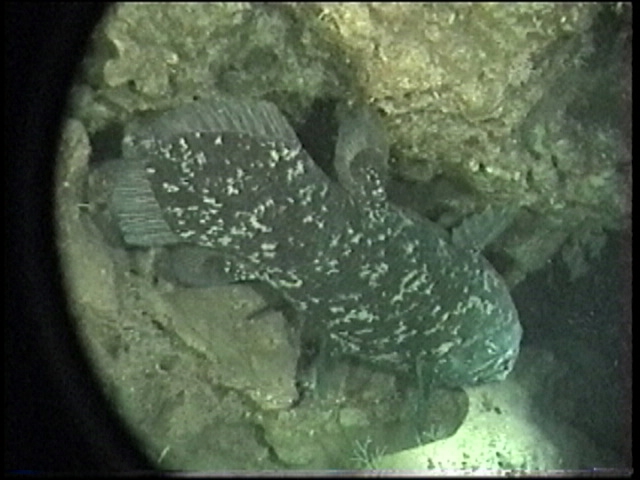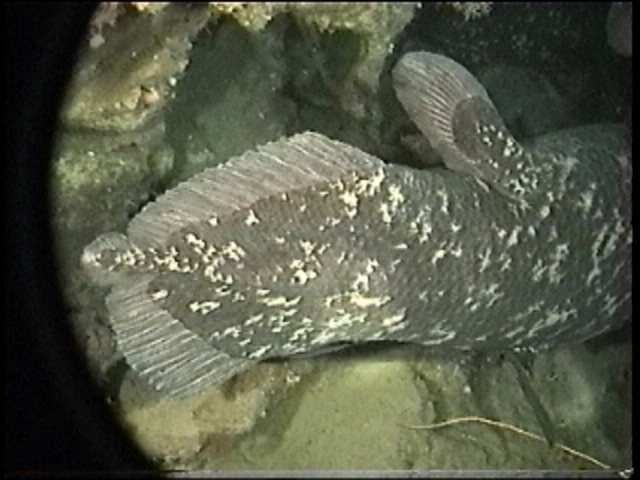
Coelacanths discovered off the Natal Coast.
Herewith the text of an article to be published in the South African Journal of Science later this month.
DISCOVERY OF A
VIABLE POPULATION OF COELACANTHS
(LATIMERIA
CHALUMNAE SMITH, 1939) AT SODWANA BAY, SOUTH AFRICA
Pieter Ventera, Peter Timm, Gilbert Gunn, Etienne le Roux, Christo Serfontein, Pieter Smith, Erna Smith, Martin Bensch, Dennis Harding and Phillip Heemstrab*
“Other scientists are
more cautious, but I am optimistic that there is a coelacanth
population off the African mainland, perhaps off central
Mozambique, northern Natal or the Transkei. New submersible
technology and renewed access will hopefully answer these
intriguing questions in the near future.”
– Mike Bruton1,
March 1992.
On October 28th 2000, Pieter Venter, Peter Timm and Etienne le Roux were near the end of an eight-minute initial exploratory dive to 104 m in the Jesser Canyon at Sodwana Bay, in the St Lucia Marine Reserve on the north coast of South Africa (Fig. 1). As they were about to ascend, the first author (PV) saw a large, pinkish eye reflecting the beam of his underwater light. He approached, and underneath an overhang he saw a fish about two metres long. After a few seconds he realised, much to his surprise, that the pale blue fish with its unusual lobed fins was a coelacanth. He summoned Peter Timm, and they saw two more coelacanths. Timm, who was concerned with their ascent, was unable to confirm the sighting. But later, on the surface, Venter convinced him that these fish were coelacanths, and the divers then decided to arrange an expedition to do additional dives with a video camera to record the presence of this species.
On November 27th a dive was planned to 115 m with a 15 minute bottom time; the divers were Pieter Venter, Gilbert Gunn and cameramen Christo Serfontein and Dennis Harding. The support divers were Pieter Smith, Martin Bensch and Etienne le Roux. After searching caves along the wall of the canyon for 12 minutes, three coelacanths were sighted and filmed with the video camera (Figs 2 & 3) at a depth of 108 m. The largest fish was between 1.6 and 1.8 m in length, and the other two coelacanths were about 1.5 and 1.0 m. The water temperatures at the bottom for the October and November dives were 17 °C and 18 °C respectively.
a P.O. Box 101423 Moreleta Plaza 0167, South
Africa, pcrventer@hotmail.com.
b J.L.B. Smith Institute of Ichthyology, Private
Bag 1015, Grahamstown 6140 South Africa.
*Author for correspondence.
After 15 minutes, the divers started their ascent as planned, but at a depth of 70 to 60 m, some problem involving Harding and Serfontein resulted in their uncontrolled ascent to the surface. Harding lost consciousness soon after surfacing and was rushed to the beach. Efforts to resuscitate him were unsuccessful. Serfontein was also unconscious when he reached the surface, but with the assistance of Pieter Smith, he regained consciousness and was able to descend immediately to a depth of 32 m to resume his decompression schedule. After 134 minutes in the sea, Serfontein was taken to the beach, administered oxygen and transported to Richards Bay for 6 hours of treatment in a decompression chamber.

Figure 2. Adult Latimeria chalumnae, filmed at 108 m in Jesser Canyon at Sodwana Bay. This image was extracted from the videotape taken by Christo Serfontein.

Figure 3. Enlarged image of caudal fin and second dorsal fin of same fish shown in Figure 2, taken by Christo Serfontein.
DISCUSSION
The fossil record of coelacanths,2 comprising some 120 species arrayed in about 47 genera and three or four families, extends from the Middle Devonian (380 million years ago) to the end of the Cretaceous (70 million years ago), when the coelacanths were thought to have died out, along with the dinosaurs and many other fossil groups. The first fossil coelacanth was described in 1836, and the group is now well known in the literature on fossil fishes. The genus name Coelacanthus (meaning “hollow spine”) refers to the hollow neural and haemal spines of the vertebrae that connect to the tubular pterygiophores supporting the dorsal and ventral caudal fin rays3. Three extinct species are known from South African fossils, one in KwaZulu-Natal, one from the Free State, and one from Grahamstown2,4. Most fossil coelacanths are known from marine deposits, but a few were adapted to freshwater. They attained their maximum diversity (in number of species) in the Triassic Period (some 200 million years ago), but disappeared from the fossil record at the end of the Cretaceous2. Consequently, the zoological world was astounded when a living coelacanth (Latimeria chalumnae Smith, 1939) was discovered off the Chalumna River near East London5 in December 1938. Coelacanths have changed little over the past 380 million years. The skeleton of Macropoma mantelli, which is known from the Upper Cretaceous, is virtually identical to that of the living coelacanth and differs little from the skeleton of most Devonian coelacanths2.

Marjorie Courtenay-Latimer's sketch of the coelacanth sent to JLB Smith upon the discovery of the original specimen of Latimeria chalumnae.
Although only a single specimen of Latimeria chalumnae has been caught off South Africa, the discovery of this first specimen did much to put South Africa and J.L.B. Smith on the ichthyological map of the world. Thanks to the efforts of J.L.B. and Margaret Smith, Marjorie Courtenay-Latimer, French anatomists, and more recently, Hans Fricke’s observations and films of coelacanths in their natural habitat at Grand Comoro, we have learned much about this fascinating fish 6-10. Since 1952, when the “home” of the coelacanth was discovered in the Comoros, more than 180 coelacanths have been caught with hook and line in depths of 35– 600 m on the steep volcanic slopes of Grand Comoro and Anjouan Island 8,9. A gravid coelacanth was trawled off the central coast of Mozambique 10 and a specimen was also caught in a shark net near Toliara on the southwest coast of Madagascar 11. The recently discovered coelacanths near Manado at the northern end of Sulawesi, Indonesia seem to be a separate species 12.

Figure 1. Western Indian Ocean, showing sites for previous captures of Latimeria chalumnae (white stars) and new discovery (black star) at Sodwana Bay, South Africa.
In May 1991, a
project organised by Prof M.N. Bruton (then Director of the
J.L.B. Smith Institute of Ichthyology) brought Prof
Hans Fricke and his submersible JAGO to South Africa to look for
coelacanths and survey the faunal diversity in depths of 50-400 m
along the coast of the Eastern Cape Province Fifteen dives
totalling 23h 45 min were carried out at depths of 35-110 m in
the Tsitsikamma National Park on the Eastern Cape coast, and 8
dives totalling 23h 30 min were done to depths of 370 m on the
continental shelf and slope off the Chalumna River Mouth.
No coelacanths were sighted during the survey, nor were
large caves seen off the Chalumna River, as the friable sandstone
terraces of the slope in this region is not conducive to
formation of caves; in several places, the roofs of overhangs
were seen to have collapsed after being eroded too far.
The continental shelf off the coast of northern KwaZulu-Natal is narrow (approximately 3 km wide, with a shelf break at –45 to –70 m, and along this coast there are some 13 canyons that begin at depths of –30 to –40 m within 1 or 2 km of shore and plunge to depths of –650 m within 8 km of shore.13 The beachrock/aeolianite walls of the Jesser Canyon where the Sodwana coelacanths were sighted are evidently more sturdy and suited to cave formation than the slope sedimentary rock off the Chalumna River. The sheltered habitat of this V-shaped canyon is also less exposed to the strong Agulhas Current than the lower relief slope off the Eastern Cape Province. The similar canyons along the coast of northern KwaZulu-Natal and Mozambique are also likely to be suitable habitat for coelacanths.
Because of the difficulty in sampling and observing fishes in rough bottom habitats below depths of 50 m, the fish fauna of these habitats is poorly known. This discovery of a small population of coelacanths at a depth of 104 m at Sodwana Bay, a popular dive site in South Africa, emphasises how little we know about life in the oceans and the need for further exploration and survey work to assess the fish diversity of southern Africa and the Western Indian Ocean.
The sighting of juvenile (1 m) and adult (1.6 to 1.8 m) coelacanths on two separate dives implies a viable population of Latimeria chalumnae in a marine protected area (St Lucia Marine Reserve), and this is good news for the conservation of this apparently endangered species. The Minister of the Department of Environmental Affairs and Tourism has acted swiftly to legislate for the protection of the population, and a management plan is being prepared by the KwaZulu-Natal Nature Conservation Service in collaboration with the Marine and Coastal Management division of the Department of Environmental Affairs and Tourism.
We express our condolences to family and friends of our fellow diver, Mr Dennis Harding. We are grateful to Mr André Slade of Inner Space Developments, for the use of his underwater video equipment. We thank Robin Stobbs. M.N. Bruton and Eric Anderson for their useful comments on the manuscript.
Photographs of the coelacanths in this article are used courtesy of Pieter Venter and were taken by Christo Serfontein. They may not be reproduced without their permission.
References:
1. Bruton M.N.
(1992). The mingled destinies of coelacanths and men.
ICHTHOS, Newsletter Soc. Friends J.L.B. Smith
Inst. Ichthyol. 33, 1-3.
2. Forey P. (1998). History
of the Coelacanth Fishes. Chapman & Hall.
3. Agassiz, L. (1836). Recherches
sur les poissons fossiles. Neuchâtel, Switzerland,
Vol. 2, Part 2, 1-136.
4. Anderson M.E., Long J.A.,
Evans F.J., Almond J.E., Theron J.N. and Bender P.A.
(1999). Biogeographic affinities of Middle and Late Devonian
fishes of South Africa. Rec.
W. Austr. Mus. Suppl. 57, 157-168.
5. Smith J.L.B. (1939). A
surviving fish of the Order Actinistia. Trans. Roy. Soc.
S. Afr. 27(1), 47-50.
6. Fricke H., Schauer J.,
Hissmann K., Kasang L. and Plante R. (1991). Coelacanth Latimeria
chalumnae aggregates in caves: first observations in the
resting habitat and social behaviour. Envir. Biol.
Fishes 30, 281-285.
7. Fricke H.W. and Hissman K.
(1994). Home range and migrations of the living coelacanth Latimeria
chalumnae. Mar. Biol. 120, 171-180.
8. Bruton M.N. and Stobbs R.E.
(1991). The ecology and conservation of the coelacanth Latimeria
chalumnae. Envir. Biol. Fishes 32, 313-339.
9. Stobbs R.E. and Bruton
M.N. (1991). The fishery of the Comoros, with
comments on its possible impact on coelacanth survival. Envir.
Biol. Fishes 32,
341-359.
10. Bruton M.N., Cabral A.J.P.
and Fricke H.W. (1992). First capture of a coelacanth, Latimeria
chalumnae (Pisces, Latimeriidae), off Mozambique. S. Afr. J. Sci. 88, 225-227.
11. Heemstra P.C., Freeman
A.L.J., Wong H.Y., Hensley D.A. and Resandratana H.D.
(1996). First authentic capture of a coelacanth, Latimeria
chalumnae (Pisces: Latimeriidae), off Madagascar. S.
Afr. J. Sci. 92, 150-151.
12. Holder M.T., Erdmann M.V.,
Wilcox T.P., Caldwell R.L. and Hillis D.M. (1999).
Two living species of coelacanths? Proc. Nat. Acad. Sci.
96, 12616-12620.
13. Ramsay P.J. (1996). Quaternary marine geology of the Sodwana Bay continental shelf, northern KwaZulu-Natal. Council Geosci. Geol. Survey S. Afr Bull. 117, 1-85.